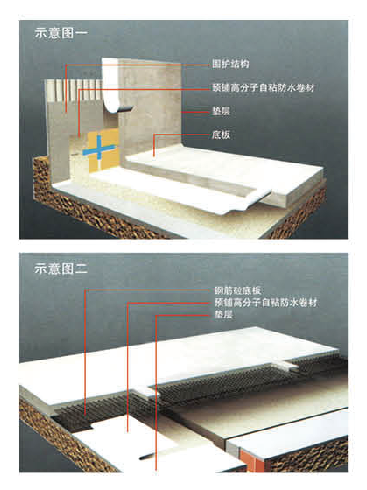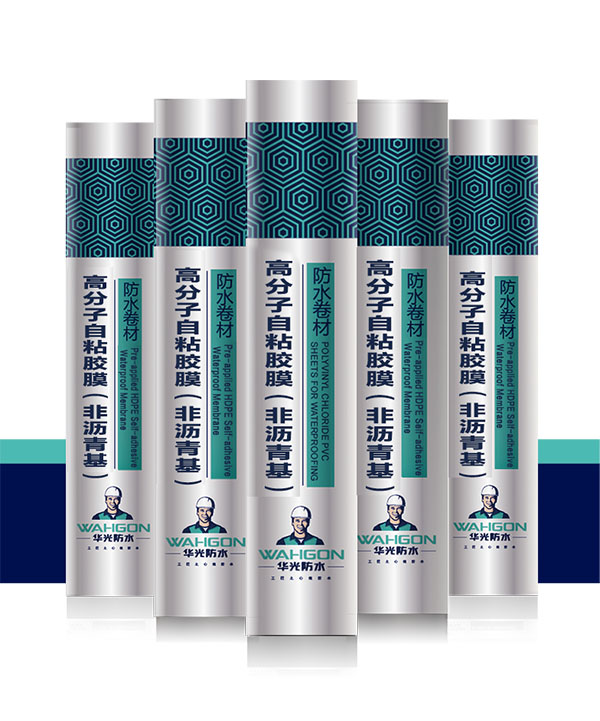PRODUCT OVERVIEW
Self adhesive polymer (non asphaltic) waterproof material, waterproof material is designed for building waterproof laying site developed by the polymer sheet, polymer membrane, self adhesive film, anti sticking layer, is non asphaltic base polymer pre developed for fusion and concrete structure Pu waterproofing membrane.
Under the action of pressure, the polymer self - adhesive film and the raw cement paste in the concrete do not start to creep and permeate to the anti - sticking layer to form an effective inter - adhesion and huge intermolecular force. After the concrete is solidified, the space between the polymer pre - installed waterproof roll and the main structure of the concrete is sealed permanently to the maximum extent, and the water channeling passage is completely eliminated.
PRODUCT FEATURES
1. pre bonding
With the subsequent pouring of concrete as one, long-term bubble is still inseparable, to solve the pre paved (outside anti internal) waterproof problems.
2. bonding reliable, easy to overhaul
The waterproof coiled material is closely bonded with the post pouring concrete. Any local failure of the coil, the water will be limited to a very small range, not channeling, even if there are individual leaks, leakage point will be consistent with the damage point, easy to overhaul.
3. the base level requirements are low, saving time limit
Humidity and even the flat surface can be built without painting, the construction of high degree of freedom, free from the weather, the construction of the rainy season, the advantages are more prominent, is to protect the duration of the most powerful weapons".
4. safety and environmental protection
In the construction process, the solvent and fuel are omitted, thus avoiding environmental pollution and fire hazard and saving resources.
5. excellent physical properties
Possess excellent tensile strength, elongation, root resistance, weather resistance, to meet the basic deformation capacity and performance.
6. optimal performance price ratio
And after pouring concrete layers together to build the extraordinary "skin" type strong waterproof system, high reliability, but also can save the traditional cement mortar layer, fine stone concrete protective layer, save costs, low cost.
application area
Waterproof basement, subway, tunnel, water pool, inclined roof and flat roof and other parts, especially suitable for the waterproof engineering special environment, high water requirements; green planting roof; to prevent the leakage of underground gas, methane and other gases.
Construction technological process
1 construction process of flat coil
Clean the grass roots to the basic level of the elastic line: laying waterproof coiled material: coil lap to detail node processing self inspection repair repair acceptance banding steel reinforced concrete pouring
2 Construction process of facade coil
The facade envelope (or installation board) base leveling, detection, cleaning, membrane localization of elastic line elevation base, laying waterproof and mechanical fixation, details, membrane lap processing, self inspection, repair, inspection, and reinforced concrete tie
Main points of construction operation
1 laying of flat coil
When laying first sheets of material, place the coiled material on the base surface according to the elastic line. The surface of the HDPE film with smooth surface is facing the base, and the weather resistant granular layer faces the construction personnel, and the location of the coil is carefully corrected. The adjacent second coils in the long side direction and first pieces of coil lap width is 70mm, when the lap joint operation, first to tear off the membrane at the overlap of the separation membrane, to ensure that the lap area of the following parts clean, dry and dust-free. When the two pieces of sheets have been lapped together, the construction shall be continuous, and the lapping lap shall be forced to ensure the good bonding of the lapping edges. Repeat the operation until the entire surface of the coil is finished.
Coil short side lap width is 80mm, the coil special glue or tape along the short side lap seam compaction glued; short side two consecutive coil lap joints should be staggered at least 600mm, to avoid the formation of concentrated uplift.
2 elevation roll laying
When the surface is paved, the coiled material is aligned on the base of the retaining wall according to the position of the elastic line, and the smooth polyethylene film faces the retaining structure, and the weather resistant granular layer faces the structural concrete wall. The coiled material is fixed on the supporting surface of the retaining wall by mechanical fixing method, and the nail fixing position shall be at 5mm outside the reserved self-adhesive edge of the coil. According to the actual situation of the site, the long side of the coil is fixed mechanically at about 500mm. During construction, the long side of the film is torn off and the adhesive film on the lap surface of the adhesive tape is reserved to carry out the long side lap joint, and all the nail fixing points are covered by the lap edge of the adjacent coil. Immediately after the lap with pressure roller, to ensure that the cement seal.
According to the actual situation in the field, the short edge of the coil is fixed at every 500mm or so, and the nail is fixed away from the outer edge of the coil. 5mm. After completion of the nail fixing work, the short side lapping parts are sealed and sealed with special rubber or adhesive tape, and all the nail fixing points are covered by the lap edge of the lower roll.
3 waterproof layer repair
Before binding steel mesh, supporting formwork and pouring concrete, the waterproof layer and waterproof layer should be checked carefully. Found damaged, should be repaired in time, so as not to leave leaking water hidden dangers. Repair of damaged point, roll cut not less than 150mmx150mm, covering in the damaged area, with special glue or tape to repair material and sealing, integrally formed with the waterproof layer, pouring concrete in the coil structure as soon as possible after installation. Before pouring concrete, measures should be taken to ensure that the accepted coil surface is clean and free of impurities, so as to achieve the purpose of effectively bonding the coil with the concrete. In the process of pouring concrete, it is necessary to operate with care to prevent man-made damage to the waterproof layer of the coil.


